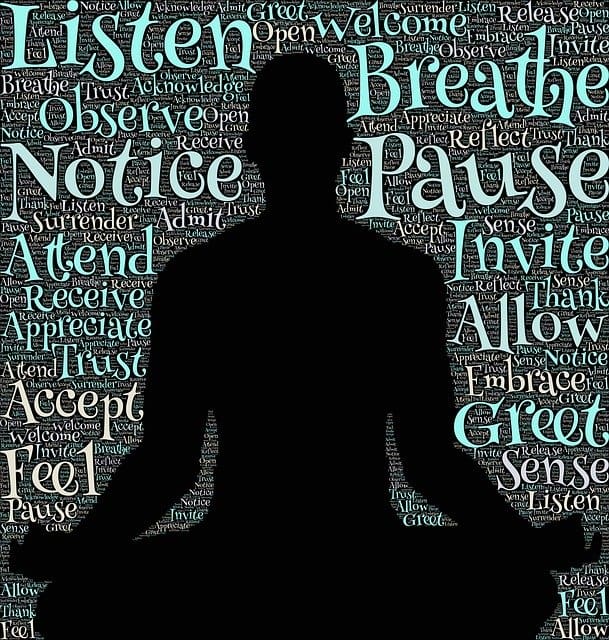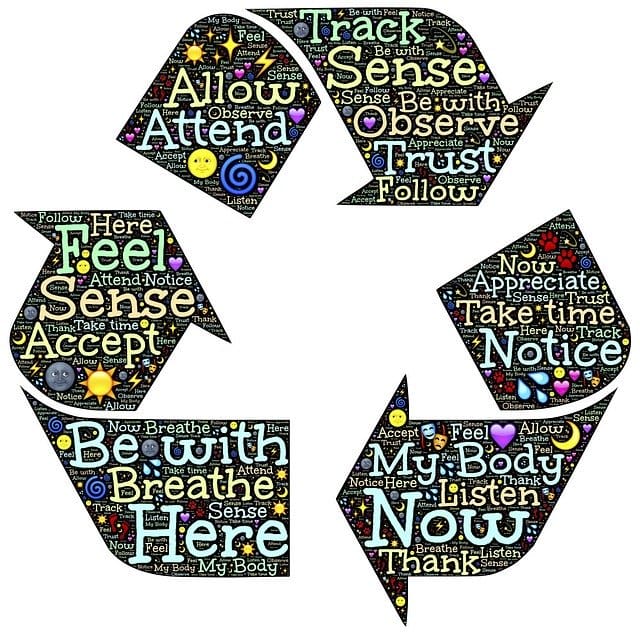Mindfulness is a hot topic these days. You may have heard it mentioned on the news, read about it in an article or seen people talking about mindfulness on social media. Maybe you are wondering what this whole thing means and how to apply it? I am here to help! In this article, we will be exploring the 4 foundational elements of mindfulness and how they can be applied to your everyday life. So grab a cup of tea (or beer or whiskey, I’m not judging), take some deep breaths, and let’s get started.

KEY POINTS
- A mindfulness practice has four foundational elements: Mindfulness of the Body, Mindfulness of Feeling Tones, Mindfulness of the Mind, and Mindfulness of How the Mind Operates.
Mindfulness & Meditation in Context
Both mindfulness and meditation have been a core part of most Buddhist traditions for over 2,500 years. Traditions such as Vipassana and Zen meditations are where these practices are rooted. However, mindfulness has only really become a buzzword in western culture in the last 50 years.
Many modern forms of mindfulness and meditation practices, such as Mindfulness-Based Stress Reduction (MBSR), present, teach and practice mindfulness in a 100% secular and non-religious way – no religious terms, philosophy, or rituals. The benefits of mindfulness aren’t dependent on any dogma, belief system, or spiritual practice.
This is much the same way your gym might offer a yoga class (which also has its roots in religious traditions) from a non-religious perspective and format.
The term Mindfulness originates from the Pali word “sati,” which means awareness, attention, and remembering. In modern days, and to incorporate mindfulness into our everyday lives, it’s being used to address clinical conditions and include qualities such as compassion, non-judgment, and acceptance.
One of the foremost pioneers in Therapeutic Mindfulness, Jon Kabat-Zinn, defines it as “the awareness that emerges through paying attention on purpose, in the present moment, and non-judgmentally to the unfolding of experience moment to moment.”
Why Mindfulness Is Such A Hot Topic
There are several reasons why mindfulness is such a hot topic these days. Mainly, it’s due to increasing scientific evidence that mindfulness practice has substantial benefits for the brain, body, and relationships. Research has shown these benefiting our mental well-being, increasing our ability to concentrate, bolstering our resilience, successfully treating chronic pain, and enabling us to become more compassionate.
Mindfulness, from a therapeutic or secular perspective, means conscious awareness of the present experiences with acceptance. These words are found in most of the modern psychological literature you will find on Mindfulness. Therapeutic Mindfulness is often coupled with other types of therapy, such as Cognitive-based Therapy (CBT), Dialectical Behavior Therapy (DBT), or Acceptance and Commitment Therapy (ACT).

Other terms that have been used to describe therapeutic Mindfulness are: “affectionate awareness,” “mindful compassion,” “mindful acceptance,” “wholehearted presence,” or “open-hearted presence.”
These therapeutic approaches have provided us with a great deal of research on the positive benefits of practicing mindfulness and meditation. Many of these benefits are enhancing overall mental health, reducing stress, and providing a sense of well-being. As mindfulness in our modern western culture has been adapted to our current information age, it has developed with new methods, different meanings, and differing perceptions. While many ancient practices are still incorporated, many people shy away from this move toward a more secular approach. This more secular approach focuses on physical experiences, like breath work, to cultivate awareness and acceptance of the present moment and what is going on with us internally.
Despite all of the research and many benefits, many in our society often reject mindfulness and meditation. Usually, this is due to cultural stigma, a misunderstanding of the practices, or they don’t fit into our fast-paced and instant-gratification valued lifestyles (all the more reason to incorporate mindfulness).
Misunderstanding Mindfulness
There are lots of misconstrued ideas about meditation, especially in western civilization. Mindfulness is not about being mindless about your thoughts or surroundings, nor about not having any emotions. It is also not about wiping your mind clean, seeking a blissful life, withdrawing from life, or escaping pain. Instead, it helps you be aware of and with managing all of that.
It’s also something that shouldn’t solely be focused on reducing or managing stress. While that is a key benefit and one that frankly most people are initially drawn to, our focus should be on understanding ourselves to make us better human beings. That’s what makes the world a better place for us individually and collectively.
After all, a mass-murderer can be mindful and completely aware of and present in the moment as he/she commits unspeakable acts. We need to practice “right mindfulness” working to not only make ourselves better. We also need to carry on beyond that to make the people around us and our world better.
That awareness and acceptance of the present moment, it no easy task. Our minds will often wander, thoughts pop up and make their presence known, feelings (both physical and emotional) come to the surface. To deal with this, accept the wandering mind without judgment. Notice where your mind went before bringing your focus back to the present.
If you’re suffering from an overwhelming traumatic experience, learning mindful acceptance can significantly increase the chances of overcoming suffering. You may consider seeking out a counselor that incorporates Therapeutic Mindfulness into their practice.

Mindful Awareness
Mindfulness practiced this way is not necessarily focused on relaxation, though that could be a result. The focus is on increasing awareness of the thoughts, feelings, and actions that hinder our growth and progress. When we’re better able to do that, we can engage with those aspects within ourselves, learn to tweak, and choose how to respond.
If you become more aware and yet don’t have acceptance or are placing judgment, it can be hard to deal with your emotions. If you add acceptance in a much lighter sense, it can bring about a much softer, therapeutic mindful experience.
To be clear, acceptance isn’t resignation. Acceptance is not about allowing yourself to be powerless to your circumstance, having no free will, or adopting some nihilistic, laissez-faire, withdrawn attitude about things. Instead, acceptance acknowledges things for what they are, as they are, and only for that. Not our perception of them or our emotional reaction to them.
It doesn’t mean our external circumstances don’t change, or we won’t have difficult, sometimes painful situations. Instead, it means that you can be at ease with anything and everything. It’s going beyond thinking or any concept of good or bad. It is the result of having the ability to be fully present and fully aware, here and now, just as you are.
The more intense your suffering, the more you need to be accepting and compassionate to change what is going on in your life.
Kindness and compassion are also important. These need to be incorporated into your awareness so that the difficulties in your life can be addressed. Without awareness, your acceptance of or resignation to the problem could turn into defensive avoidance.
Get the free guide Quiet Confidence: A Men’s Guide to Living a Free, Authentic, Joyful, Centered, & Purposeful Life”
This workbook will provide you with an introduction to mindfulness as a foundation for living a more deliberate, authentic, purposeful life of peace, freedom, health, and fulfillment.
You’ll also signup for the newsletter to get valuable content right in your inbox.
Your privacy is respected. Data will never be sold or shared. Unsubscribe at any time.
Foundational Elements Of Mindfulness
A mindful practice like this has four foundational elements: Mindfulness of the Body, Mindfulness of Feeling Tones, Mindfulness of the Mind, and Mindfulness of How the Mind Operates.
Mindfulness of the Body
Mindfulness of the body is the starting point and anchor to the present moment. As the name implies, it’s merely being aware of what’s happening in each area of your body. What physical sensations are there? What emotional connotations are there? You do this through a body scan, where you simply “scan” your body by focusing your attention on an area individually and being aware of what you find. It’s a grounding meditation that helps us to heighten awareness of the sensations we’re experiencing within our bodies.
You’ll find a lot of guided meditation start with a body scan. The body scan can also be practiced as its own meditation. By focusing on our physical being consciously, we deepen the mind-body connection. This focused awareness can also help manage pain better to locate the presence of emotion within the body and deepen our relaxation experience.
Mindfulness of the Feeling Tones
By being mindful of the body, each sensation we experience can be categorized as pleasant, unpleasant, or neutral. These are the feeling tones that accompany emotions. This isn’t a judgment about what we’re feeling. Instead, it’s noting and labeling it.
Feeling Tones are different from emotions. They are pleasant, unpleasant, and neutral. When you’re in your meditation, you can use these feeling tones to understand better how you feel about the thought, feeling, or sensation you’re experiencing. Focus on each tone by visualizing something strongly related to each one individually. Notice what is going on in your body – what you’re feeling, where is the sensation, does it change your breathing? Store this into your sense memory and use this as a baseline to recognize the tones.
Mindfulness of the Mind
The brain is a highly complex system with more than 80 billion neurons connected in an incredibly intricate network. And even though this sending and receiving of these signals are biochemical, this creates something large and complex…the stream of consciousness.
As you begin to explore mindfulness of the mind further, you start to become more aware of this stream of consciousness. Consciousness is the steady stream of pictures representing thoughts and emotions that continually stream on multiple screens in your mind at lightning speed. This stream is the stream of consciousness. We jump from one idea to the other. Often, when we describe how we feel, we’re defining an extremely condensed interpretation of what is going on in this stream.
We are not aware of precisely what is happening in our stream of consciousness. We have many thoughts and feelings that come from outside (other people, what we read, see, etc.). These are easy to recall and wildly inaccurate to our true nature and our thoughts. It’s those unprocessed thoughts and feelings that come from deep within us and contain the most information even if they are of the hardest to make sense.
Our brains are more messy and delicate than we imagine. By being mindful of our stream, we can learn what’s going on. We can become experts in our stream of consciousness, which is how we understand who we truly are. That knowledge can lead us to make changes and align our lives with how we genuinely feel and achieve our congruent goals with our true nature.
Mindfulness of How the Mind Operates

This is mindfulness of the objects of the mind. In observing how the mind operates, you begin to become aware of the forms of existence, virtues, or awakening. This might seem like it’s getting into metaphysical or religious territory. And that’s not wrong. However, this doesn’t mean you need to get into deep philosophical thought or adopt new religious dogma. This is how we go beyond just trying to relax and make ourselves better human beings by discovering and living our true nature.
This mindfulness is more about understanding how your mind works, how you process things, how your feelings surface, what you value, what you want, what makes you “you.” Have you been around someone who knew exactly what they want out of life? They mean what they say, and they act on it. They’re passionate and confident, to the point where people around them feel it and inspire them. That’s the power of congruency, having a connection between who you are, what you believe, and what you are doing.
Practicing this “mindfulness of the objects of the mind” enables us to be aware of these elements of our deep-rooted nature and help us to work towards that congruency.
We also need to be kind to ourselves. We need to be self-compassionate and self-accepting as we try to make sense of our world under even the most trying of circumstances. You need to allow your heart to be fully open to having your eyes fully open as well.
When practicing mindfulness by ourselves, we must be emotionally aware to allow self-acceptance to take place. If you are in a therapeutic mindfulness setting, acceptance and compassion are essential for the process to become effective.
Final Thoughts
Practicing mindfulness teaches us to become grounded within ourselves. It’s about tapping into our inner resources for healing our well being, joy, and fulfillment. As we approach our practice being mindful consistently, we can begin to gain control of our thoughts and emotions through these four focus areas. From there, we can start to control our ability to respond differently to even the most difficult situations. We can adopt an empowered, growth mindset that allows us to make wise decisions based on facts, rather than habits, conditioning, or emotion.
“Good questions outrank easy answers.” – Paul A. Samuelson (American economist)
- As you practice mindfulness, what are you noticing in your mind?
- Are there any shifts within your practice?
- How do you think awareness of the feeling tones could be healing for you?
Want more? Get the free guide “Quiet Confidence: A Men’s Guide to Living a Free, Authentic, Joyful, Centered, & Purposeful Life“
This workbook will introduce mindfulness as a foundation for living a more deliberate, authentic, purposeful life of peace, freedom, health, and fulfillment.






